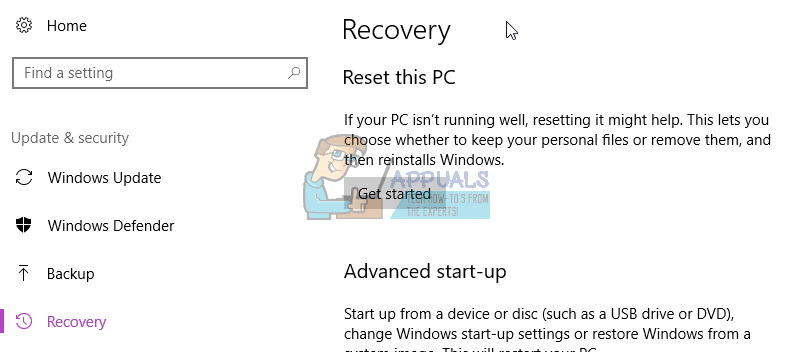How to: Reset a Windows 10 Computer
Windows 10 allows users to reset their computers. Resetting a Windows 10 computer basically returns the computer’s Operating System to the way it was when it was booted up for the first time – any and all third-party applications that did not come with the computer are uninstalled, and all changes made by the user to the computer’s settings and preferences are nullified. As far as the user’s personal files and data stored on the computer are concerned, the user has the option to either keep them or remove them when resetting the computer.
Resetting a Windows 10 computer basically gives it a fresh start, which can be extremely useful if you are experiencing a software-related issue with your computer and can’t seem to get rid of it. In fact, completely resetting your computer is the only known solution to a significant number of problems that are known to affect Windows 10 users. Resetting a Windows 10 computer is much like stripping it down to its core – all programs that didn’t come pre-installed are uninstalled and all settings are nullified, although personal data is or isn’t deleted depending on the choice the user makes. Microsoft has also made resetting Windows 10 computers a fairly simple affair. There are two different ways you can go about resetting a Windows 10 computer:
Method 1: Resetting the computer from within Windows
If you are able to successfully log in to Windows, resetting your Windows 10 computer should be a pretty simple process. All you need to do is:
- Open the Start Menu.
- Click on Settings.
- Click on Update & security.
- Click on Recovery in the left pane.
- In the right pane, click on Get Started under Reset this PC.
- Click on either Keep my files (if you want the computer to be reset without losing any of the files stored on it) or Remove everything (if you want the computer to be reset and any and all data stored on it to be deleted). If you plan on using the Remove everything option, it is recommended that you back up any data/files that you don’t want to lose before proceeding with the reset.
- If you clicked on Remove everything in the last step, click on either Just remove my files (if you only want your files deleted) or Remove my files and clean the drive (if you would like to have your files deleted and your Hard Disk cleaned, which takes longer than its alternative). If you clicked on Keep my files in the last step, skip this step.
- If presented with a warning, simply click on Next.
- On the next screen, review the particulars of the reset and click on Reset to initiate the process.

Once you click on Reset, the computer will restart and then take a few minutes to reset itself. When/if prompted with a screen that has three options on it and asks you to choose one, click on Continue.
Note: Whether you choose the Keep my files option or the Remove everything option, all of your programs and apps will be uninstalled, so you are going to have to reinstall them once your computer has been successfully reset. Resetting a Windows 10 computer also results in all settings and preferences being reset to their default values.
Method 2: Resetting the computer without logging in to Windows
If you, for some reason, are unable to log in to Windows, you can still reset your computer from Windows 10’s Boot Options menu. The Boot Options menu appears automatically if your computer fails to boot properly 2-3 times in a row. However, if the menu doesn’t automatically appear, you can bring it up by holding down the Shift key, clicking on the Power icon on the Windows login screen, and clicking on Restart – when the computer reboots, it will boot into the Boot Options menu instead of the Windows login screen. To reset a Windows 10 computer from the Boot Options menu, you need to:
- Click on Troubleshoot out of the three options provided.
- Click on Reset this PC.
- Perform steps 6–9 from Method 1, and then wait for the computer to restart and reset itself.
- When/if prompted to select one of three options after the PC has been reset, click on Continue.
